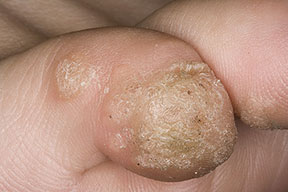Verruca vulgaris
Verruca plana
Flat wart (Verruca plana): a small, smooth flattened wart, tan or flesh coloured, which can occur in large numbers; most common on the face, neck, hands, wrists and knees
Verruca filiformis
Filiform or digitate wart: a thread- or finger-like wart, most common on the face, especially near the eyelids and lips

Verruca pedis
Plantar wart (verruca, Verruca pedis): a hard sometimes painful lump, often with multiple black specks in the center; usually only found on pressure points on the soles of the feet
Verruca acuminata
Genital wart (venereal wart, Condyloma acuminatum, Verruca acuminata)